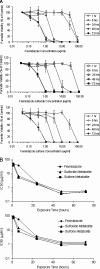Antitrypanosomal activity of fexinidazole, a new oral nitroimidazole drug candidate for treatment of sleeping sickness
- PMID: 21911566
- PMCID: PMC3232772
- DOI: 10.1128/AAC.00246-11
Antitrypanosomal activity of fexinidazole, a new oral nitroimidazole drug candidate for treatment of sleeping sickness
Abstract
Fexinidazole is a 5-nitroimidazole drug currently in clinical development for the treatment of human sleeping sickness (human African trypanosomiasis [HAT]), caused by infection with species of the protozoan parasite Trypanosoma brucei. The compound and its two principal metabolites, sulfoxide and sulfone, have been assessed for their ability to kill a range of T. brucei parasite strains in vitro and to cure both acute and chronic HAT disease models in the mouse. The parent molecule and both metabolites have shown trypanocidal activity in vitro in the 0.7-to-3.3 μM (0.2-to-0.9 μg/ml) range against all parasite strains tested. In vivo, fexinidazole is orally effective in curing both acute and chronic diseases in the mouse at doses of 100 mg/kg of body weight/day for 4 days and 200 mg/kg/day for 5 days, respectively. Pharmacokinetic data indicate that it is likely that the sulfoxide and sulfone metabolites provide most, if not all, of the in vivo killing activity. Fexinidazole and its metabolites require up to 48 h exposure in order to induce maximal trypanocidal efficacy in vitro. The parent drug and its metabolites show no in vitro cross-reactivity in terms of trypanocidal activity with either themselves or other known trypanocidal drugs in use in humans. The in vitro and in vivo antitrypanosomal activities of fexinidazole and its two principal metabolites provide evidence that the compound has the potential to be an effective oral treatment for both the T. b. gambiense and T. b. rhodesiense forms of human sleeping sickness and both stages of the disease.
Figures
References
-
- Balasegaram M., et al. 2009. Effectiveness of melarsoprol and eflornithine as first-line regimens for gambiense sleeping sickness in nine Medecins Sans Frontieres programmes. Trans. R. Soc. Trop. Med. Hyg. 103: 280–290 - PubMed
-
- Bernhard S. C., Nerima B., Maser P., Brun R. 2007. Melarsoprol- and pentamidine-resistant Trypanosoma brucei rhodesiense populations and their cross-resistance. Int. J. Parasitol. 37: 1443–1448 - PubMed
-
- Bronner U., et al. 1991. Pentamidine concentrations in plasma, whole blood and cerebrospinal fluid during treatment of Trypanosoma gambiense infection in Côte d'Ivoire. Trans. R. Soc. Trop. Med. Hyg. 85: 608–611 - PubMed
-
- Brun R., Schumacher R., Schmid C., Kunz C., Burri C. 2001. The phenomenon of treatment failures in human African trypanosomiasis. Trop. Med. Int. Health 6: 906–914 - PubMed
Publication types
MeSH terms
Substances
LinkOut - more resources
Full Text Sources


